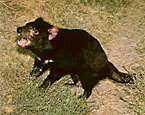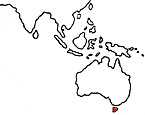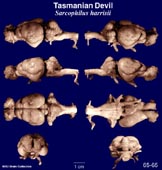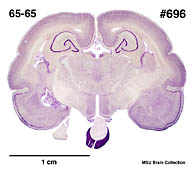|
Tasmanian
Devil
(Sarcophilus harrisii) #65-65 |
||||
|
MSU Tasmanian Devil Brain Sections
|
Physical
characteristics and distribution
|
|
Tasmanian
Devil Sarcophilus harrasii The
diet consists of a variety of vertebrates and invertebrates
including poisonous snakes, and a small amount of plant material.
The main food source is carrion, as the Tasmanian Devil is an
inefficient killer. Preferred are wallabies, wombats, sheep,
and rabbits. Every part of the carcass is consumed, including
the fur and bones. The single living species of Sarcophilus today is harrasii, is found only in Australia: Tasmania. It probably once occupied most of the Australian mainland, but was in direct competition with the introduced dingo. |
|
Description
of the brain
|
|
The brain weight is 16.26 g (includes R. Trg. & L.C2 DRG). The brain meaurements are: Length AP left 28.1 mm; Length AP right 28.5 mm; Bitemporal width 30.2 mm; Temporal height left 22.1 mm; Temporal height right 22.7 mm. |
|
Animal
source and preparation
|
|
All
specimens collected followed the same preparation
and histological procedure.
|
Other Related Resources (websites and publications)



